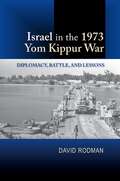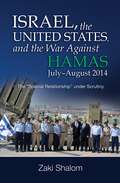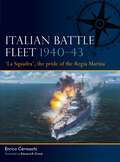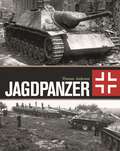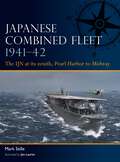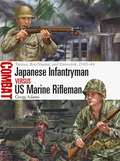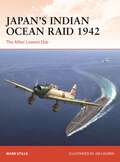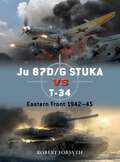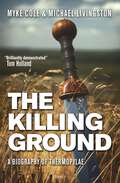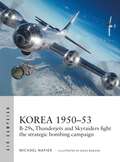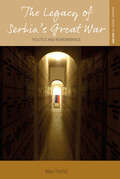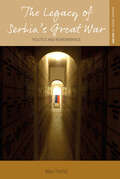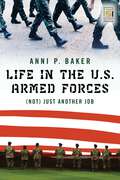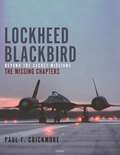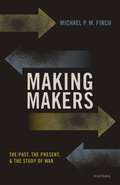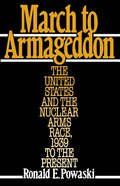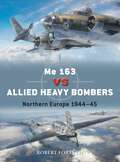- Table View
- List View
Israel in the 1973 Yom Kippur War: Diplomacy, Battle and Lessons
by David RodmanThe State of Israel faced one of its most difficult challenges during the 1973 Yom Kippur War. Though the Israel Defense Forces (IDF) eventually emerged as the clear victor in the war, it suffered serious reverses at the outset of hostilities, as well as substantial losses in men and equipment. This book revisits the Yom Kippur War by exploring a number of issues that have not previously received the attention they deserve or that would benefit from a fresh evaluation. Among the issues examined are: the American-Israeli and Jordanian-Israeli relationships during the war; the roles of Israeli nuclear weapons and airpower; the IDF's practice of combined arms warfare; the reasons why the IDF turned the tide of the war more quickly on the Golan front than on the Sinai front; the impact of American arms transfers; and the lessons derived from the war by the United States Army and the IDF. This book, which relies heavily on government documents and other primary sources of information, fills important descriptive and analytical gaps in the academic literature about the Yom Kippur War. No other book compares to it in respect of content and interpretation. It is, in short, essential reading for all scholars interested in the diplomatic and military dimensions of the war.
Israel, the United States, and the War Against Hamas, July-August 2014: The Special Relationship under Scrutiny
by Professor Zaki ShalomOperation Protective Edge, launched on July 8, 2014, saw heavy fighting between the Israel Defense Forces and Hamas in Gaza. Throughout the war US government media spokespersons confirmed Israels right to self-defense against rockets and tunnels, and condemned Hamas for initiating the conflict and its use of human shields. But there is an important difference between confirmation and pro-active demonstration at the highest political level. The longstanding alliance between the United States and Israel has always been subject to the administration and president of the day. In this case, the Obama administrations support for Israels right to self-defense was qualified, and as a result the Israeli political leadership felt constrained in its ability to defeat Hamas militarily without risking criticism from the United States that would impact negatively on the special relationship. In its role as ally, the United States was careful not to apply direct political pressure on Israel. However, US government public criticisms relating to Gazan civilian loss of life damaged Israel on the international stage via harrowing media coverage surrounding the conflict. The Federal Aviation Administration order to airlines to stop flying to Israel enhanced Hamas claim that it had inflicted a strategic defeat to the Zionist State. For the last 70 years Israel has recognized that the United States is its primary strategic ally a principle initiated by Israels first Prime Minister and Defense Minister, David Ben-Gurion. Political and military policies have to be directed to prevent a rift. But the Protective Edge experience has brought to the fore that in times of crisis Israel cannot rely on a special relationship to secure its safety and must of necessity possess the political will and military ability to defend itself and to take actions that may result in a strained relationship.
Israel's Intelligence Assessment Before the Yom Kippur War: Disentangling Deception and Distraction
by Aryeh ShalevIsrael's flawed intelligence assessment in October 1973 has been studied intensively and been the subject of much public and professional debate. This book adds a unique dimension to previously disclosed material, as its author served as head of the Research Branch of Israeli Military Intelligence on the eve of and during the Yom Kippur War and as such was responsible for the national intelligence assessment at the time. Drawing on his personal records, and on interviews and extensive research conducted in the intervening decades, Aryeh Shalev examines the preconceptions and common beliefs that prevailed among Israeli intelligence officials and ultimately contributed to their flawed assessment: the excessive self-confidence in Israel's prowess, particularly in the aftermath of the Six Day War; the confidence that any surprise attack could be repelled with the regular army until the reserves were mobilised; the accepted profile of Sadat as a weak leader with limited powers and initiative; and the belief in Israel's correct understanding of Egyptian and Syrian operational plans . . . Beyond explaining where Israeli intelligence erred, the book probes expectations of military intelligence in general and the relationship between military and political assessments. It considers what kind of assessment an intelligence branch is capable of producing with a great degree of certainty, and conversely, what kind of assessment it should not be asked to produce. Based on the intelligence failure of the Yom Kippur War, this book also reviews possible organisational changes and methodological improvements to guard as much as possible against surprise attacks in the future, relevant not only to Israel's circumstances but to all countries with enemies capable of launching an attack. Published in association with the Institute for National Strategic Studies.
Italian Battle Fleet 1940–43: 'La Squadra', the pride of the Regia Marina (Fleet #6)
by Enrico CernuschiA comprehensive. illustrated account of the wartime Italian battle fleet, from its ships and technology to command structure, logistics, codebreaking and more.In the 1920s, the Italian Navy faced great challenges. Mussolini's ambitious Italy turned away from its alliance with Britain and France, and the Regia Marina faced the prospect of confronting both the French Navy and the Mediterranean Fleet of the Royal Navy. In the years leading up to World War II, the Regia Marina built and deployed a powerful battleship-led fleet – known in Italy as 'La Squadra' – intended to make the Mediterranean an Italian sea once more. In this book, Italian naval historian Enrico Cernuschi offers a fresh assessment of the wartime Italian battle fleet, based on his lifetime of primary-source research from both Italian and Allied sources. It offers a comprehensive portrait of this proud armada, how it was devised and built, and how it operated and fought. It covers a multitude of factors often overlooked, such as Italy's naval codebreakers, the fleet's logistics, and the qualities and limitations of Italian industry that supported it. The book also provides a concise account and analysis of the battle fleet's activities through the war, from major clashes such as the Battle of Calabria to lesser-known expeditions. The author's research into Italian wartime primary sources overturns some myths still commonplace in Anglo-American accounts. Illustrated with superb new artwork, maps and 3D diagrams, and featuring rare photos, this book is a fascinating account of Italy's great fleet of World War II.
Jagdpanzer
by Thomas AndersonThis highly illustrated title details the history of the Jagdpanzer, the self-propelled German tank destroyers introduced in the second half of World War II. Throughout World War II all sides grappled with how to deal with the threat of enemy armour. The German Army had adopted the 3.7cm anti-tank gun in the inter-war years. However, it was already apparent that the towed weapons lacked firepower and more powerful weapons were introduced in 1942 and 1943.By 1942, hard-pressed Panzerjäger (anti-tank) units equipped with towed anti-tank weapons fighting on the Eastern Front increasingly sought assistance from StuG-equipped assault artillery units. By late 1943 the StuG was being issued to new tank destroyer units and at the same time a dedicated Jagdpanzer (hunting tank) was ordered, based on the chassis and running gear of the PzKpfw IV.This highly illustrated study by German armour expert Thomas Anderson uses archival material and after-action reports to describe the development of the Jagdpanzer, and the many variants built on other German tank chassis. It also covers in detail how Jagdpanzer units were organized as well as their operational experience on the battlefield.
Japanese Combined Fleet 1941–42: The IJN at its zenith, Pearl Harbor to Midway (Fleet #1)
by Mark StilleLaunching Osprey's new Fleet series, this is a spectacularly illustrated, concise and comprehensive account of the Imperial Japanese Navy's striking force at the height of its power.The Imperial Japanese Navy (IJN) entered the Pacific War as one of the most formidable navies in the world, and its combat power was concentrated into one force, the Combined Fleet. In the months that followed Pearl Harbor it enjoyed an unrivaled string of victories, shattering American, British, Australian, and Dutch naval forces. This period of expansion and constant victories ended at the Battle of Midway, after which the Combined Fleet was forced onto the defensive. In this book, Mark Stille draws on his decades of IJN research to explain what made the Combined Fleet the fighting force that it was. Packed with superb original artwork, explanatory 3D diagrams and maps, it examines the fleet's doctrine, innovative tactics and powerful warships. It also details the qualities and importance of IJN leadership, logistics, naval infrastructure, and Japan's shipbuilding capability, and gives an account and analysis of the IJN's combat performance during these crucial months – not just in the famous carrier battles, but also exploring lesser-known elements such as IJN amphibious forces and land-based aviation.
Japanese Infantryman vs US Marine Rifleman: Tarawa, Roi-Namur, and Eniwetok, 1943–44 (Combat #75)
by Gregg AdamsFeaturing evocative artwork plates and carefully selected photographs, this book assesses the US Marines and Japanese troops who contested the islands of Tarawa, Roi-Namur, and Eniwetok during 1943–44. On November 20, 1943, amphibious vehicles carrying Marines of the 2d Marine Division reached the shores of Betio Island in the Tarawa Atoll, defended by a determined Japanese garrison that would fight to the last man. This began a test by combat of over two decades of US studies, analyses, and planning for capturing and defending naval bases in Micronesia. The Tarawa assault was followed in February 1944 by the rapid capture of the Kwajalein and Eniwetok atolls in the Marshall Islands. In these battles US Marines fought a mix of Imperial Japanese Navy and Imperial Japanese Army ground units. All but a handful of the defenders, whether they were organized ground combat troops or infantry improvised from aviators and service troops, were determined to die for the Emperor while killing as many of the enemy as possible. In this study, Gregg Adams shows how the US Marine Corps and US Navy drew upon these pivotal actions to improve their tactics, organization, and equipment for the next round of amphibious operations. He also explains how their Japanese opponents – realizing that isolated island garrisons were doomed to destruction or isolation if the Imperial Japanese Navy could not defeat the US Navy at sea – moved from seeking to repel an invasion to one inflicting maximum American casualties through prolonged defensive fighting.
Japan’s Indian Ocean Raid 1942: The Allies' Lowest Ebb (Campaign #396)
by Mark StilleAn detailed illustrated exploration of the Japanese raid into the Indian Ocean in April 1942 – one of the largest operations conducted by the Imperial Navy during the war.In the wake of Japan's conquest of Burma in early 1942, plans were formed by the Imperial high command to capture Ceylon (modern Sri Lanka) to consolidate Japan's defensive perimeter and disrupt British shipping lanes to India, Australia, and the Middle East. The Imperial Japanese Army, however, could not release sufficient troops for an invasion, and so in response the Japanese Navy developed Operation C, an aggressive raid by the Combined Fleet into the Indian Ocean. The key objective was to destroy the British Eastern Fleet in port.Expert naval historian Mark Stille documents the high point of Japanese naval air power as its carriers struck Ceylon – the heart of British naval power in the East – sinking several Allied ships. He describes the Allied air attempts to destroy Admiral Chuichi Nagumo's force, and the Japanese attacks against British shipping and the cities along the Indian coast.Specially commissioned battlescenes bring to life the sinking of British carrier Hermes, the Bristol Blenheim attacks on the Japanese carrier force, and a Zero vs Hurricane dogfight over Colombo on 5 April. Easy to follow maps and diagrams reveal the strategic situation at the start and end of the campaign, and track the movements of the Japanese carrier task force and the British Eastern Fleet throughout. Details of weaponry, equipment, personnel and the events of the fascinating battles that took place are revealed in over 60 photographs, many of which are from Japanese sources.
Jet Turbine engine cross section (UEB Contracted)
In these diagrams of a jet engine, there is a cross section view through the length of the engine at the top of the page and in the bottom right of the page, a front view of the engine intake. There is a locator dot shown, which will be at the top left of the page when the image is the right way up. On the left of the page air is forced into the engine by the compressor which has many fan blades. The compressed air is fed into the combustion chamber in the middle of the page. Fuel is injected into the engine through a port in the lower centre part of the combustion chamber. This is where combustion and gas expansion takes place. On the right of the page the exhaust exits past the turbine producing the thrust of the engine. The front view shows the circular opening of the engine with lots of fan blades arranged around the central hub like a huge fan.
Jet Turbine engine cross section (UEB Uncontracted)
In these diagrams of a jet engine, there is a cross section view through the length of the engine at the top of the page and in the bottom right of the page, a front view of the engine intake. There is a locator dot shown, which will be at the top left of the page when the image is the right way up. On the left of the page air is forced into the engine by the compressor which has many fan blades. The compressed air is fed into the combustion chamber in the middle of the page. Fuel is injected into the engine through a port in the lower centre part of the combustion chamber. This is where combustion and gas expansion takes place. On the right of the page the exhaust exits past the turbine producing the thrust of the engine. The front view shows the circular opening of the engine with lots of fan blades arranged around the central hub like a huge fan.
Ju 87D/G STUKA versus T-34: Eastern Front 1942–45 (Duel #129)
by Robert ForsythAn examination of two of the most high-profile air and land weapons to be deployed on the Eastern Front in World War II.In late 1942, as part of its attempts to strike back at ever-increasing numbers of Soviet tanks, the German air ministry authorised the development of an adaptation and enhancement of the longspan Junkers Ju 87D-5 Stuka dive-bomber. The aircraft was duly fitted with two underwing pods containing 37 mm BK cannon – an antiaircraft cannon with its origins dating back to 1933. The solid, slow, Ju 87 airframe offered the Luftwaffe an ideal platform for specialist, low level, 'tank-killing' operations. Despite the wealth of experience possessed by some of the Luftwaffe's ground-attack and dive-bomber aces, knocking out T-34 tanks from the air was a demanding and difficult process. Nevertheless, some Luftwaffe pilots notched up impressive tank scores, and the Ju 87 is credited with the destruction of more than 100 tanks across the central and southern sectors of the Eastern Front, including during the Battle of Kursk. Including personal accounts from Stuka pilots and biographies of the anti-tank aces, together with detailed photographs of the cannon installation into the Ju 87G and details of the construction of the T-34 illustrated using specially commissioned artwork, this book covers the epic clash of two legendary machines of World War II.
The Killing Ground: A Biography of Thermopylae
by Myke Cole Dr Michael LivingstonAn exploration into why and how Thermopylae is one of the most blood-soaked patches of ground in history – and what its past can tell us about our future.'Brilliantly demonstrated.' - Tom HollandSince the dawn of the Classical Era up to World War II, thousands have lost their lives fighting over the pass at Thermopylae. Historians Cole and Livingston provide an exciting account of each of the 27 battles and holding actions that took place. The epic events of 480 BC when 300 Spartans attempted to hold the pass has been immortalised in poetry, art, literature and film. But no history has ever detailed the other events from the very first battle through to the battles fought by Romans, Byzantines, Huns and Ottomans during the early and late medieval periods and finally the two desperate struggles against German occupying forces during World War II. The Killing Ground details the background and history of each conflict, the personalities and decision making of the commanders, the arms and tactics of the troops, and how each battle played out. Cole and Livingston have surveyed the ground to provide a boots-on understanding of each battle. Their command of multiple ancient and medieval languages means they have provided their own translations of much of the source material, ensuring new insights into each battle. This uncompromising scholarship is woven together into a compelling and unforgettable history that grips the reader from start to finish.
Korea 1950–53: B-29s, Thunderjets and Skyraiders fight the strategic bombing campaign (Air Campaign #39)
by Michael NapierA spectacularly illustrated new history and analysis of the strategic bombing campaign in the Korean War, which saw the last combat of America's legendary B-29s. Just five years after they defeated Japan, at the dawn of the jet age, the most advanced bomber of World War II was already obsolescent. But the legendary war-winning Superfortresses had one more war to fight, in the strategic air campaign against North Korea. The bombers' task was to destroy North Korea's facilities for waging war, from industry and hydroelectric dams to airfields and bridges. However, it was a challenging campaign, in which the strategy was not merely military but political. In this fascinating book, airpower scholar and former RAF pilot Michael Napier explains how the campaign was fought, and how the technique of 'bombing to negotiate' that would become notorious in Vietnam was already being used in Korea. He analyses in detail the relationship between battlefield progress, armistice negotiations and the bombing strategy developed over the complex campaign. In the skies over Korea, the B-29s operated in a new world dominated by jet fighters and jet age technology, and tactics were developing rapidly. Packed with original illustrations, this book includes dramatic air scenes featuring B-29s, MiG-15s, AD Skyraiders and Skyknight jet nightfighters in action. It also includes maps, 3D recreations of missions and explanatory 3D diagrams to bring the conflict to life. This is a fascinating, dramatic account of the last battles of the piston-engined aircraft era as the superpowers vied for victory in the first clash of the Cold War.
The Legacy of Serbia's Great War: Politics and Remembrance (Making Sense of History #48)
by Alex TomićIn the winter of 1915, following the invasion of Serbia by the Central Powers, the Serbian Army retreated across the mountains of Albania and Montenegro together with thousands of civilians. Around 240,000 lost their lives. Today, the story of the retreat is little known, except in Serbia where it is represents the heroic Serbian sacrifice in the Great War. In this book Alex Tomić examines the centenary events memorializing the First World War with the retreat at its core, and provides a persuasive account of the ways in which the remembrance of Serbian history has been manipulated for political purposes. Whether through commemorations, ceremonies, or grass- root initiatives, she demonstrates how these have been used as distractions from the more recent unexamined past and in doing so provides an important new perspective on the cultural history of commemoration.
The Legacy of Serbia's Great War: Politics and Remembrance (Making Sense of History #48)
by Alex TomićIn the winter of 1915, following the invasion of Serbia by the Central Powers, the Serbian Army retreated across the mountains of Albania and Montenegro together with thousands of civilians. Around 240,000 lost their lives. Today, the story of the retreat is little known, except in Serbia where it is represents the heroic Serbian sacrifice in the Great War. In this book Alex Tomić examines the centenary events memorializing the First World War with the retreat at its core, and provides a persuasive account of the ways in which the remembrance of Serbian history has been manipulated for political purposes. Whether through commemorations, ceremonies, or grass- root initiatives, she demonstrates how these have been used as distractions from the more recent unexamined past and in doing so provides an important new perspective on the cultural history of commemoration.
Len Deighton 3-Book War Collection Volume 1: Bomber, Xpd, Goodbye Mickey Mouse
by Len DeightonThree classic novels of the Second World War by the ‘greatest war novelist of our time’, together in one e-bundle for the first time.
The Letters of Franklin K. Lane
by Louise Herrick Wall Anne Wintermute Franklin K. LaneA selection of letters written by Franklin K. Lane.
Library for the War-Wounded
by Monika HelferFrom Monika Helfer's award-winning, internationally bestselling wartime trilogy, based on her own family. Translated into English for the first time.'We called him Vati, Dad. Not Father, not Papa. That's what he wanted. He thought it sounded modern. He wanted to present himself to us, and through us, as a man in tune with the modern age. Though he seemed to come from nowhere.'Josef was an illegitimate child, a charity case from Salzburg, schooled by a benefactor. He was drafted to fight in the Second World War while still at school and sent to Russia, returning with only one leg. He married his nurse, and brought his family to the high, idyllic slopes of the Austrian Alps, where he took a position as manager of a home for injured soldiers, a strangely suspended, deeply isolated place with a remarkable library.He was a man of many mysteries. To his daughter, Monika, none was greater than his obsession with these cloistered, crumbling books, his great treasure and secret amidst a country barrelling away from the memory of war.Beautifully written, restrained, and memorable, Library for the War-Wounded turns a real life into great literature by confronting the universal question: Who are our parents, really?
Life in the U.S. Armed Forces: (Not) Just Another Job (Praeger Security International)
by Anni BakerAnni Baker has created a fascinating exploration of life in the armed forces, as it has been experienced by millions of men, women, and children over the past six decades. Her book examines the factors that shape military service and military culture, from grueling training exercises to sexual relations with local women, from overseas duty to the peculiar life of the military brat. The book begins with an examination of the enlistment process, follows the military lifecycle through career decisions, promotions, raising families, and retirement, explores the impact of war on military society, and ends with a discussion of the place of the armed forces in the United States. A wide variety of sources were used in this study, including contemporary scholarship, government and military records, public media, and, most important, interviews and written materials from military personnel, retirees, family members, and civilian employees. Using a lively and readable style, Baker blends clear explanations of elements of military life, information on the development of military society, and the voices of those who serve into an insightful account of this fascinating subculture.It is the author's view that not only is study of the U.S. military a valuable undertaking in itself, but in addition it will enrich our perspective on civilian life and culture in the United States. The military is a distinct society based on a set of common values that are sometimes, though not always, at odds with those of civilian society. The extent to which active duty personnel, family members and civilians internalize these values dictates their comfort with military life and their choice of a military career. Through a discussion of life in the military, Baker examines how the values, traditions and norms of the armed forces are articulated and shared, how they influence the individual and the institution, and what their role is in American society as a whole.
A Little Maid of Old Maine
by Alice Turner CurtisTo help the men of Machias, Maine, capture an English gunboat in June 1775, Rebecca and Anna undertake a dangerous journey through a forest to get ammunition for them-- based on a true story of the brave effort of two girls to bring help to a little settlement on the Maine coast at the time of the Revolution.
Lockheed Blackbird: Beyond the Secret Missions – The Missing Chapters
by Paul F. CrickmoreThe SR-71 Blackbird is an iconic aircraft that has come to symbolize America's technological superiority during the Cold War. Using recently declassified information, globally renowned expert Paul Crickmore updates his definitive account of the aircraft. The Lockheed SR-71 Blackbird ranks as one of the most elegant, sleek and powerful aeroplanes ever designed. But it was not built to be admired – it was built not to be seen at all. The high-altitude aerial reconnaissance sorties it was to perform were top secret and carefully concealed from public knowledge. However, as the aircraft have become museum pieces and details of their work declassified, the whole story of their design and operation can finally be told. This updated edition of Paul Crickmore's classic Lockheed Blackbird: Beyond the Secret Missions is based on 850 pages of documentation and images declassified by the CIA covering the A-12 Oxcart programme. These highly significant documents range from discussions at the highest levels of the US government concerning the rationale for Oxcart's development and eventual deployment, to extremely detailed intelligence data gleaned from each of the 29 operational missions flown by Oxcart during Operation Black Shield. The Blackbird family of aircraft continue to fascinate a wide age group and, since the aircraft will never fly again, its history has become timeless. This new edition will provide the last word on the SR-71 Blackbird and its operational history.
Making Makers: The Past, the Present, and the Study of War
by Michael P. FinchMaking Makers presents a comprehensive history of a seminal work of scholarship which has exerted a persistent attraction for scholars of war and strategy: Makers of Modern Strategy. It reveals the processes by which scholars conceived and devised the book, considering both successful and failed attempts to make and remake the work across the twentieth century, and illuminating its impact and legacy. It explains how and why these influential volumes took their particular forms, unearths the broader intellectual processes that shaped them, and reflects on the academic parameters of the study of war in the twentieth century. In presenting a complete genesis of the Makers project in the context of intellectual trends and historical contingency, this book reflects on a more complex and nuanced appraisal of the development of scholarship on war. In so doing it also offers contributions to the intellectual biographies of key figures in the history of war in the twentieth century, such as Edward Mead Earle, Peter Paret, Gordon Craig, and Theodore Ropp. Making Makers contributes to an intellectual history of military history and contextualises the place of history and historians in strategic and security studies. It is not only a history of the book, but a history of the networks of scholars involved in its creation, their careers, and lines of patronage, crossing international boundaries, from Europe to the USA, to Asia and Australia. It is an investigation of ideas, individuals, and groups, of work completed and scholarship produced, as well as contingency and opportunities missed.
March To Armageddon: The United States And The Nuclear Arms Race, 1939 To The Present
by Ronald E. PowaskiMe 163 vs Allied Heavy Bombers: Northern Europe 1944–45 (Duel #135)
by Robert ForsythAn illustrated account of the dramatic engagement between the Luftwaffe's Me 163 units and Allied bombers during the closing years of World War II.In the summer of 1944, US Army Air Force (USAAF) aircrews flying over the Third Reich reported observing small, high-speed 'batlike' aircraft flying close to their formations. The Luftwaffe's extraordinary Messerschmitt Me 163 rocket-powered interceptor was making its devastating debut with Jagdgeschwader (JG) 400. Capable of reaching high altitudes in the shortest possible time by using a volatile rocket fuel, the Me 163 was the Luftwaffe's most impressive yet dangerous aircraft, and the fastest in the world. Luftwaffe expert Robert Forsyth details the testing of the aircraft and its lethal SG 500 'Fighter Fist' weapons system, as well as its deployment against the B17s and B24s of the USAAF's Eighth Air Force and, from late 1944, the Lancasters and Halifaxes of RAF Bomber Command. These duels started a deadly form of warfare, with the bomber squadrons striking at Germany's synthetic oil refineries and jet airfields, and the Me 163s of JG 400 trying to stop them using cutting-edge aeronautical technology.Using specially commissioned artwork, original photographs and rare first-hand interviews with the pilots that fought the decisive dogfights, this exciting book describes the pivotal encounters over Northern Europe.
